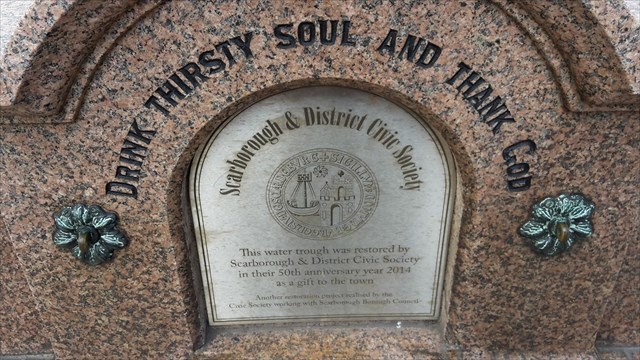
The Curry Micro series was originally conceived in Sussex by two curry loving Geocachers by the names of BHA LOYAL and proftonks back in 2012.
On a recent trip to Scarborough I was partaking of a fine portion of chips and curry sauce when I stumbled across a super example of a water trough dating from the reign of King Edward VII. That lead to the creation of this EarthCache....From the published coordinates to waypoint 2 you can enjoy a stroll along a busy section of the sea front.

The scientific study of the Earth's structure, composition and processes of formation and evolution is called Geology. Of particular interest to Geologists are rocks - where they came from, how they were formed, etc.
The three main types of rock are:
a) Sedimentary
When small pieces of material are carried along by flowing water and/or the wind, they can become deposited at points where the flow slows down. For example at the entry point into a lake from a river or at the crest of a sand dune. Over time the deposited material accumulates in layers (sediments). The upper layers gradually compact the lower layers and the water is squeezed out in a process called compaction. The squeezed out water contains dissolved minerals and acts as a glue binding the small pieces of rock together. Over millions of years the sedimentary rocks are formed.
Sedimentary rocks have layers and contain grains of material. Fossils may be found where plants and animals have become trapped as the layers settle.
Two common examples of sedimentary rocks are:
- Limestone (which is formed from sediments laid down in warm and shallow waters. The deposits include muds, sands and the skeletons of organisms including corals and molluscs. Limestones come in many colours from dark reds, dark browns and dark greys through to the purest white. Most often they are creamy in colour and any fossils present are surrounded by grains of fine material.)
- Shale (which is formed from muds and clays. Shales are often grey in colour. They are crumbly because the layers are weakly bonded together and so fall apart easily.)
b) Igneous
The formation of igneous rock can take place in two places: Either deep inside the Earth where the temperatures are high enough for the rock to remain liquid (This liquid rock is called magma), Or at the surface of the Earth where the magma emerges from volcanoes as lava. When the magma cools down it becomes solid and depending on a number of factors including the speed of cooling it will take different forms and have different visible characteristics.
Igneous rocks have crystals of different sizes but never contain fossils.
Two common examples of igneous rocks are:
- Granite (which forms underground and has larger crystals as it has cooled slowly. Crystals in granite are generally lighter in colour and can include grey-coloured quartz, pink or white feldspars, and black smaller crystals of biotite and other minerals rich in silicates)
- Basalt (which forms during volanic eruptions and has smaller crystals as it cooled quickly in the air. Basalts can also form under water, where the lava will also cool quickly. Basalts are dark in colour, sometimes with smaller pieces of lighter coloured materials. It is possible that these lighter coloured materials filled ancient gas bubbles that are now preserved in the rock.)
c) Metamorphic
A metamorphic rock is created when an existing rock (igneous or sedimentary) is chemically changed by extreme heat or extreme pressure. It does not simply melt but rather the minerals within it are altered. If the metamorphic rock is formed from a sedimentary rock, any fossils present will not persist as they will be destroyed. A metamorphic rock can also form from an existing metamorphic rock being changed by extreme heat or pressure or a mixture of both.
Two common examples of metamorphic rocks are:
- Marble (which is formed from limestone and has a sugary texture. The marble can be of a single colour or have "veins" of a variety of colours)
- Slate (which is formed from shale. Slate can be split into thin hard sheets making it particularly suitable as roof tiles)
EarthCaches have no physical cache to find but there are the following tasks to perform in order that you can log your find
At the stage 2 waypoint, tasks:
1) Describe the stone that the water trough is made from - consider texture, colour, size of crystals or grains
2) Which of the rock types Sedimentary, Igneous or Metamorphic is the water trough made from?
3) What is the name of the rock the water trough is made from?
4) Who is named in the engraving towards the bottom of the water trough?
5) Optional, take a photo of yourself and/or your GPS in the general area of the water trough (but without revealing any of the answers)
Please email or message me your answers via the Message Centre. You are free to log your find once you have contacted me. You don't have to wait for a reply.
You'll find rewards, league tables and stats by visiting the Curry Micro Series website.
